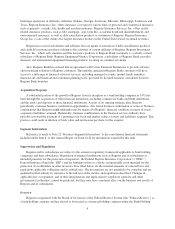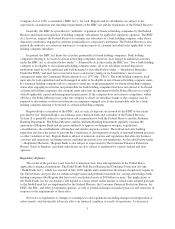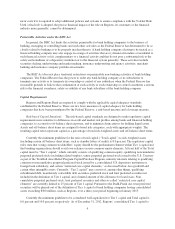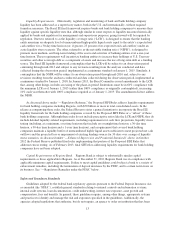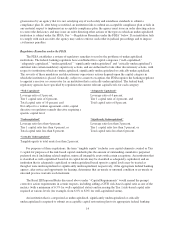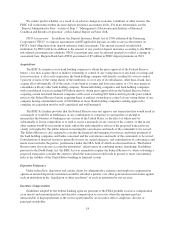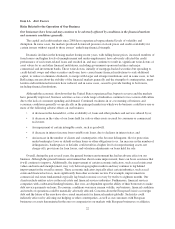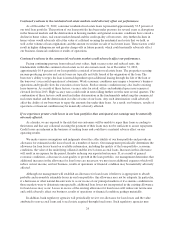Regions Bank 2012 Annual Report Download - page 30
Download and view the complete annual report
Please find page 30 of the 2012 Regions Bank annual report below. You can navigate through the pages in the report by either clicking on the pages listed below, or by using the keyword search tool below to find specific information within the annual report.
given notice by an agency that it is not satisfying any of such safety and soundness standards to submit a
compliance plan. If, after being so notified, an institution fails to submit an acceptable compliance plan or fails in
any material respect to implement an acceptable compliance plan, the agency must issue an order directing action
to correct the deficiency and may issue an order directing other actions of the types to which an undercapitalized
institution is subject under the FDIA. See “—Regulatory Remedies under the FDIA” below. If an institution fails
to comply with such an order, the agency may seek to enforce such order in judicial proceedings and to impose
civil money penalties.
Regulatory Remedies under the FDIA
The FDIA establishes a system of regulatory remedies to resolve the problems of undercapitalized
institutions. The federal banking regulators have established five capital categories (“well-capitalized,”
“adequately capitalized,” “undercapitalized,” “significantly undercapitalized” and “critically undercapitalized”)
and must take certain mandatory supervisory actions, and are authorized to take other discretionary actions, with
respect to institutions which are undercapitalized, significantly undercapitalized or critically undercapitalized.
The severity of these mandatory and discretionary supervisory actions depends upon the capital category in
which the institution is placed. Generally, subject to a narrow exception, the FDIA requires the banking regulator
to appoint a receiver or conservator for an institution that is critically undercapitalized. The federal bank
regulatory agencies have specified by regulation the current relevant capital levels for each category:
“Well-Capitalized” “Adequately Capitalized”
Leverage ratio of 5 percent,
Tier 1 capital ratio of 6 percent,
Total capital ratio of 10 percent, and
Not subject to a written agreement, order, capital
directive or regulatory remedy directive requiring a
specific capital level.
Leverage ratio of 4 percent,
Tier 1 capital ratio of 4 percent, and
Total capital ratio of 8 percent.
“Undercapitalized” “Significantly Undercapitalized”
Leverage ratio less than 4 percent,
Tier 1 capital ratio less than 4 percent, or
Total capital ratio less than 8 percent.
Leverage ratio less than 3 percent,
Tier 1 capital ratio less than 3 percent, or
Total capital ratio less than 6 percent.
“Critically Undercapitalized”
Tangible equity to total assets less than 2 percent.
For purposes of these regulations, the term “tangible equity” includes core capital elements counted as Tier
1 capital for purposes of the risk-based capital standards plus the amount of outstanding cumulative perpetual
preferred stock (including related surplus), minus all intangible assets with certain exceptions. An institution that
is classified as well-capitalized based on its capital levels may be classified as adequately capitalized, and an
institution that is adequately capitalized or undercapitalized based upon its capital levels may be treated as
though it were undercapitalized or significantly undercapitalized, respectively, if the appropriate federal banking
agency, after notice and opportunity for hearing, determines that an unsafe or unsound condition or an unsafe or
unsound practice warrants such treatment.
The Basel III Proposed Rules discussed above under “-Capital Requirements” would amend the prompt
corrective action requirements in certain respects, including adding a CET1 risk-based capital ratio as one of the
metrics (with a minimum of 6.5% for well-capitalized status) and increasing the Tier 1 risk-based capital ratio
required at various levels (for example, from 6.0% to 8.0% for well-capitalized status).
An institution that is categorized as undercapitalized, significantly undercapitalized or critically
undercapitalized is required to submit an acceptable capital restoration plan to its appropriate federal banking
14


